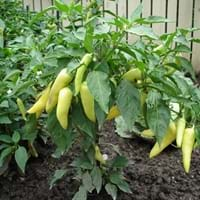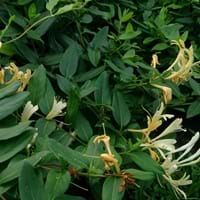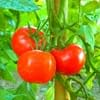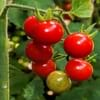Life Span
Annual
Perennial
Type
Vegetable
Flowering Plants, Shrubs
Origin
Mexico, Central America, South America
Eastern Asia
Types
Sweet Banana Pepper, Banana Bill Hybrid Pepper, Hot Banana Pepper, Inferno Hot Banana Hybrid Pepper
Not Available
Habitat
Warmer regions
Barren waste areas, disturbed sites, Fields, Forests, Wet lands
USDA Hardiness Zone
9-11
4-11
AHS Heat Zone
12-1
Not Available
Sunset Zone
A1, A2, A3, H1, H2, 1a, 1b, 2a, 2b, 3a, 3b, 4, 5, 6, 7, 8, 9, 10, 11, 12, 13, 14, 15, 16, 17, 18, 19, 20, 21, 22, 23, 24
Not Available
Habit
Upright/Erect
Cushion/Mound-forming
Flower Color
White, Ivory
White, Yellow
Flower Color Modifier
Bicolor
Bicolor
Fruit Color
Light Yellow, Lemon yellow, Yellow green
Black
Leaf Color in Spring
Green, Light Green
Green
Leaf Color in Summer
Dark Green
Green
Leaf Color in Fall
Dark Green, Black
Green
Leaf Color in Winter
Green
Green
Plant Season
Spring, Summer, Fall
Summer
Sunlight
Full Sun
Full Sun, Partial shade
Type of Soil
Loam
Well drained
The pH of Soil
Acidic, Neutral
Neutral
Soil Drainage
Well drained
Well drained
Bloom Time
Spring, Summer, Fall, Indeterminate
Late Winter, Spring, Summer
Tolerances
Drought
Drought
Where to Plant?
Container, Ground, Pot
Ground
How to Plant?
Seedlings, Stem Planting
Layering, Seedlings, Stem Cutting
Plant Maintenance
Medium
Medium
Watering Requirements
Over-head watering
Get enough water whenever the soil is dry
In Summer
Lots of watering
Lots of watering
In Spring
Moderate
Moderate
In Winter
Average Water
Average Water
Soil pH
Acidic, Neutral
Neutral
Soil Type
Loam
Well drained
Soil Drainage Capacity
Well drained
Well drained
Sun Exposure
Full Sun
Full Sun
Pruning
Prune after harvesting, Prune in late winter, Prune lower leaves
Remove dead or diseased plant parts
Fertilizers
All-Purpose Liquid Fertilizer
All-Purpose Liquid Fertilizer, General garden fertilizer
Pests and Diseases
Red blotch
Not Available
Plant Tolerance
Drought
Drought
Flowers
Insignificant
Yes
Flower Petal Number
Single
Single
Foliage Texture
Medium
Not Available
Foliage Sheen
Glossy
Not Available
Attracts
Bees
Bees, Birds, Butterflies
Allergy
breathing problems, inflammation in lips, Runny nose, sneezing
poisonous if ingested, Skin irritation
Aesthetic Uses
Not Used For Aesthetic Purpose
Showy Purposes
Beauty Benefits
Not Available
Not Available
Environmental Uses
Air purification
Air purification, Food for birds
Medicinal Uses
Digestive disorders, Heart problems, High blood pressure, Inflammation
Fever, Sore throat, Stomach aliments
Part of Plant Used
Fruits
Flowers, Leaves
Other Uses
Not Available
Making Perfumes, Used as Ornamental plant, Used for its medicinal properties
Used As Indoor Plant
No
No
Used As Outdoor Plant
Yes
Yes
Garden Design
Container, Edible, Herb / Vegetable, Tropical
Container, Cutflower, Dried Flower/Everlasting, Groundcover, Mixed Border, Rock Garden / Wall
Botanical Name
CAPSICUM annuum 'Park's Sweet Banana Whopper'
Lonicera japonica
Common Name
Banana Pepper, Park's Sweet Banana Whopper Pepper
Japanese Honeysuckle, suikazura, jinyinhua
In Hindi
केले मिर्च
जापानी Honeysuckle
In German
Banana Pfeffer
Japanese Honeysuckle
In French
Banana Pepper
Chèvrefeuille japonais
In Spanish
banano Pimienta
madreselva japonesa
In Greek
Πιπεριά Μπανάνα
Το ιαπωνικό αγιόκλημα
In Portuguese
Banana pimenta
Honeysuckle japonês
In Polish
Banana Pepper
wiciokrzew japoński
In Latin
Musa sapientum fixa Pepper
CISSANTHEMOS Italica
Phylum
Not Available
Magnoliophyta
Class
Not Available
Magnoliopsida
Order
Solanales
Dipsacales
Family
Solanaceae
Caprifoliaceae
Clade
Not Applicable
Angiosperms, Asterids, Eudicots
Tribe
Not Available
Not Available
Subfamily
Not Available
Not Available
Number of Species
Not Available
Properties of Banana Pepper and Japanese Honeysuckle
Wondering what are the properties of Banana Pepper and Japanese Honeysuckle? We provide you with everything About Banana Pepper and Japanese Honeysuckle. Banana Pepper doesn't have thorns and Japanese Honeysuckle doesn't have thorns. Also Banana Pepper does not have fragrant flowers. Banana Pepper has allergic reactions like breathing problems, inflammation in lips, Runny nose and sneezing and Japanese Honeysuckle has allergic reactions like breathing problems, inflammation in lips, Runny nose and sneezing. Compare all the properties and characteristics of these two plants. Find out which of these plant can be used as indoor plant. If you are interested to decorate your house and garden, find out aesthetic uses, compare them and select the plant which will beautify your surrounding. Along with beautification, try comparing medicinal and edible uses of Banana Pepper and Japanese Honeysuckle and you can choose the plant having best and most benefits.
Season and Care of Banana Pepper and Japanese Honeysuckle
Season and care of Banana Pepper and Japanese Honeysuckle is important to know. While considering everything about Banana Pepper and Japanese Honeysuckle Care, growing season is an essential factor. Banana Pepper season is Spring, Summer and Fall and Japanese Honeysuckle season is Spring, Summer and Fall. The type of soil for Banana Pepper is Loam and for Japanese Honeysuckle is Well drained while the PH of soil for Banana Pepper is Acidic, Neutral and for Japanese Honeysuckle is Neutral.
Banana Pepper and Japanese Honeysuckle Physical Information
Banana Pepper and Japanese Honeysuckle physical information is very important for comparison. Banana Pepper height is 55.90 cm and width 45.70 cm whereas Japanese Honeysuckle height is 800.00 cm and width 800.00 cm. The color specification of Banana Pepper and Japanese Honeysuckle are as follows:
Banana Pepper flower color: White and Ivory
Banana Pepper leaf color: Green, Light Green
Japanese Honeysuckle flower color: White and Yellow
- Japanese Honeysuckle leaf color: Green
Care of Banana Pepper and Japanese Honeysuckle
Care of Banana Pepper and Japanese Honeysuckle include pruning, fertilizers, watering etc. Banana Pepper pruning is done Prune after harvesting, Prune in late winter and Prune lower leaves and Japanese Honeysuckle pruning is done Remove dead or diseased plant parts. In summer Banana Pepper needs Lots of watering and in winter, it needs Average Water. Whereas, in summer Japanese Honeysuckle needs Lots of watering and in winter, it needs Average Water.





